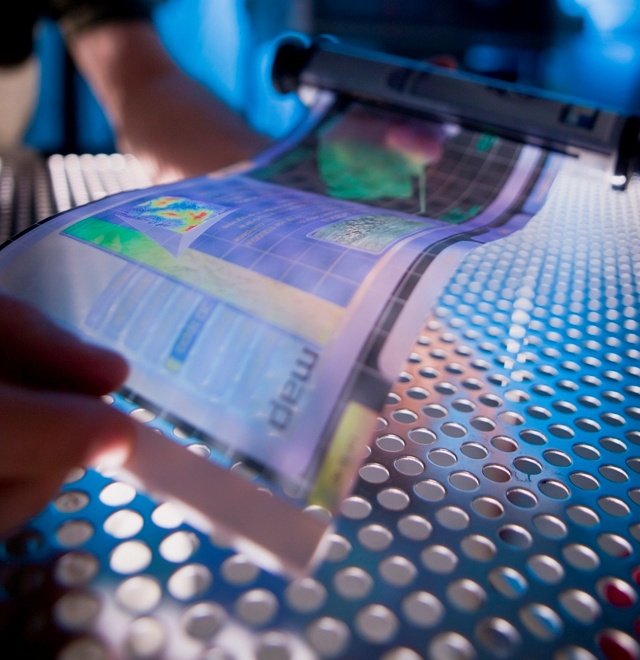
Posted on Monday, December 08 2008 @ 19:11 CET by Thomas De Maesschalck
HP and Flexible Display Center (FDC) at Arizona State University (ASU) researchers announced the first prototype of affordable, flexible electronic displays. These panels are made almost entirely of plastic, they are very flexible and consume less power than today's computer displays.
The production feat is a milestone in the industry’s efforts to create a mass market for high-resolution flexible displays. Plus, from an environmental standpoint, the displays leapfrog conventional display processes by using up to 90 percent less materials by volume.
Mass production of such displays can enable production of notebook computers, smart phones and other electronic devices at much lower costs since the display is one of the more costly components.
The unbreakable displays were created by the FDC and HP using self-aligned imprint lithography (SAIL) technology invented in HP Labs, HP’s central research arm. SAIL is considered “self aligned” because the patterning information is imprinted on the substrate in such a way that perfect alignment is maintained regardless of process-induced distortion.
SAIL technology enables the fabrication of thin film transistor arrays on a flexible plastic material in a low-cost, roll-to-roll manufacturing process. This allows for more cost-effective continuous production, rather than batch sheet-to-sheet production.
“The display HP has created with the FDC proves the technology and demonstrates the remarkable innovation we’re bringing to the rapidly growing display market,” said Carl Taussig, director, Information Surfaces, HP Labs. “In addition to providing a lower-cost process, SAIL technology represents a more sustainable, environmentally sensitive approach to producing electronic displays.”

Production of flexible displays
The first practical demonstration of the flexible displays was achieved through collaborative efforts between the FDC and HP as well as other FDC partners including DuPont Teijin Films and E Ink. To create this display, the FDC produces stacks of semiconductor materials and metals on flexible Teonex® Polyethylene Naphthalate (PEN) substrates from DuPont Teijin Films.
HP then patterns the substrates using the SAIL process and subsequently integrates E Ink’s Vizplex™ imaging film to produce an actively addressed flexible display on plastic. E Ink’s Vizplex bi-stable electrophoretic imaging film enables images to persist without applied voltage, thereby greatly reducing power consumption for viewing text.
“Producing a photolithography-free, flexible active-matrix display is an excellent example of the Flexible Display Center’s world-class development and manufacturing infrastructure,” said Shawn O’Rourke, director, Engineering, Flexible Display Center at Arizona State University. “It demonstrates how multiple industry partners can collaborate on innovative solutions, including roll-to-roll compatible technology that addresses the rapidly growing market for flexible electronics.”
“Flexible electronic displays are playing an increasingly important role in the global high-tech industry, serving as the crucial enabling technology for a new generation of portable devices, including e-readers and similar products designed to combine mobility with compelling user interfaces,” said Vinita Jakhanwal, principal analyst, Small and Medium Displays, iSuppli. “We expect the flexible display market to grow from $80 million in 2007 to $2.8 billion by 2013. The Flexible Display Center at Arizona State University is a key participant in helping to develop the technology and manufacturing ecosystem to support this market.”
